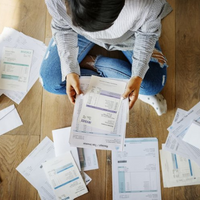Your guide to UTR codes (with a UTR number example, how to get a UTR, and what to do if you lose it)
23-09-2021| treasuryXL | XE |
Whether you want to find a UTR and use it, or you’re lost in a maze thinking of what you should do if you lose the number, we’ve got your back with a UTR number example and more!
A Unique Taxpayer Reference (UTR) number is a code that identifies you or your business in the United Kingdom for tax purposes. Her Majesty’s Revenue and Customs (HMRC), a UK government department, is responsible for collecting taxes in the country and uses your UTR number whenever it deals with your tax.
You may need a UTR for submitting a tax return to HMRC, depending on whether you meet their eligibility criteria.
Feeling foggy already? Whether you want to find a UTR and use it, or you’re lost in a maze thinking of what to do if you lose the number, we’ve got your back, so take it easy!
We’ve also thrown a UTR number example into the bargain to help you understand all of this better. Let’s get the (UTR) show going, shall we?
What’s a UTR number example?
All UTRs have 10 digits, which sometimes end with the letter ‘K’. A simple UTR number example is 12345 67890, with a gap between 2 pairs of 5 digits each.
Do I need a UTR number?
If you have forms of income or expenses that require you to file a Self Assessment tax return, you’ll need a UTR number. This applies in case you:
-
Are or were self-employed as a sole trader and you earned over £1,000 GBP (without claiming tax relief) in the last tax year (April 6 to April 5), or
-
Are a partner in a business partnership (even a nominated partner will do), or
-
Have untaxed income (like commissions, income from renting out a property, or foreign income), or
-
Want to claim an Income Tax relief, or
-
Are a subcontractor who’s either self-employed, a partner in a trust or partnership, or the owner of a limited company in the UK (in all these cases, you’ll have to register for the Construction Industry Scheme or CIS).
In the case your sole income is from your wages or pension, you won’t need to send a return.
However, keep in mind that if you submit your tax return to HMRC 3 months (or more than 3 months) later than the deadline, you may face a minimum penalty of £100 GBP, along with interest on late payments of your tax bill.
How do I find out my UTR number?
First things first, register for a tax Self Assessment, if you have to send an income tax return. You can either register online, or fill up an application form on the HMRC website, print it out, and post it to HMRC.
Once your registration process is complete, or you’ve formed a private limited company in the UK, HMRC will send you an SA250 “Welcome to self-assessment” letter.
You’ll find your UTR number on the top right of the letter, along with a 12-digit activation code (for non-personal tax accounts). This activation code is necessary for signing in to your online self-assessment account with HMRC for the first time.
In case you don’t receive the activation code, though, or you lose it within 28 days of enrolling for the online service, you can sign in to your online HMRC account and simply ask for a new code.
If you’d already registered for the self-assessment and sent a return online before, your UTR should be on your previous tax returns, payment reminders, return filing notices, and other official documents from HMRC like P45 and P60.
Look out for a 10-digit number under “Tax Reference”, just like the UTR number example we’ve included at the beginning of this article.
How long does it take to get a UTR number?
HMRC automatically issues a UTR number as soon as you register for Self Assessment or you set up a private limited company.
You’ll get a letter from HMRC with the UTR number within 7-10 working days for UK addresses, but it can take up to 21 working days, too, if you’re based abroad.
How can I get my UTR number online?
After registering for tax self-assessment and creating your online account with HMRC, you can find your UTR number online.
Log in to your HMRC account for viewing your tax returns and UTR. Plus, it has become easier now to check your UTR number online via the official HMRC app.
Is my UTR number on my payslip?
If you’ve got a payslip or PAYE coding notice that HMRC sent you, you should be able to find your UTR number there.
By the way, don’t worry if the payslip is 10 or 20 years old, as the UTR number won’t change, ever.
How much tax do I pay with a UTR number?
Let’s assume that you’re a subcontractor working on a couple of construction projects in the UK. Before your contractor can pay you for the first time, he or she must check whether you’re registered for self-employment as well as for CIS.
If the contractors find your UTR on HMRC’s list of CIS-registered subcontractors, they’ll deduct tax at a flat rate of 20% from your payments and pass it on to HMRC.
But if you haven’t given your UTR yet to your employers, or they can’t find your UTR number on the list of CIS subcontractors, they must deduct 30% tax from your pay instead. So, whether you’re living in the UK or abroad, registering for CIS is a smart idea.
You can even apply for gross payment status at the time of the CIS registration process, if you want contractors to pay you in full, without any tax deductions.
Can I have 2 UTR numbers?
No, you’ll get only 1 UTR number, whether it’s a personal UTR or one for a limited company in the United Kingdom. Even if you own multiple companies, each of those will get 1 company UTR number in the UK.
Is UTR the same as National Insurance (NI) number?
Nope. An NI number is a reference number for the country’s social security system.
You have to apply for an NI number when you’ve just turned 16 and you’re working in the UK, applying for a student loan, or you want to claim tax and other state benefits.
In fact, HMRC asks for your National Insurance number and other personal details when you register for self-assessment to get a UTR.
Can I file a tax return without a UTR number?
Long story short, no. You’re definitely going to need your UTR when you submit a self-assessment tax return for the first time.
What if I’ve lost my UTR number?
If you’ve lost or forgotten your UTR number, you can easily recover it from an HMRC document.
But when you can’t get hold of any such documents either, you can ask for your UTR by calling the Self Assessment helpline on a UTR customer service number given below:
-
0300 200 3310 (if you’re in the UK)
-
0300 200 3319 (if you’re in the UK)
-
+44 161 931 9070 (if you’re abroad)
It’s also possible to request Corporation Tax UTR from HMRC, in case you’ve got a private limited company in the UK.
For that, you’ll have to provide HMRC with your registered company name and your company registration number (CRN). HMRC will then send the UTR to the business address you had registered with Companies House.
How to contact HMRC for UTR-related and other queries
Apart from the phone numbers we’ve listed above, you can also get in touch with HMRC via:
-
Online videos and webinars. These are available for queries regarding the self-assessment.
-
Twitter. Start your tweet with the tag @HMRCcustomers for general support (please don’t mention your UTR number or any personal info, as it’s a social platform).
-
Webchat. A “speak to the adviser” link will appear whenever an adviser is available, so click on that link immediately. If you don’t, you’ll have to wait till another adviser gets available.
-
Post. Write to HMRC at this address: Self Assessment, HM Revenue and Customs, BX9 1AS, United Kingdom. You don’t need to include a city name, PO box, or street name here.
What about Unique Transaction Reference numbers?
Unique Taxpayer Reference numbers aren’t the only UTR numbers out there. You may also see the acronym refer to Unique Transaction Reference numbers. While the two numbers share an abbreviation, they are two very different things with very different uses. Unique Transaction Reference numbers are unique codes meant to help banks identify and recognize financial transactions in India. Keep an eye on this space—we’ll discuss these numbers in greater detail in a future blog post!
If you’re paying UK tax while you’re based overseas, you’ll need to make international payments to HMRC. And when you’ve got the Xe money transfer app and website at your service, you can heave a sigh of relief.
International money transfers with Xe are fast, safe, and as easy as ABC.
Get in touch with XE.com
About XE.com
XE can help safeguard your profit margins and improve cashflow through quantifying the FX risk you face and implementing unique strategies to mitigate it. XE Business Solutions provides a comprehensive range of currency services and products to help businesses access competitive rates with greater control.
Deciding when to make an international payment and at what rate can be critical. XE Business Solutions work with businesses to protect bottom-line from exchange rate fluctuations, while the currency experts and risk management specialists act as eyes and ears in the market to protect your profits from the world’s volatile currency markets.
Your company money is safe with XE, their NASDAQ listed parent company, Euronet Worldwide Inc., has a multi billion-dollar market capitalization, and an investment grade credit rating. With offices in the UK, Canada, Europe, APAC and North America they have a truly global coverage.
Are you curious to know more about XE?
Maurits Houthoff, senior business development manager at XE.com, is always in for a cup of coffee, mail or call to provide you detailed information.
Visit XE.com
Visit XE partner page













